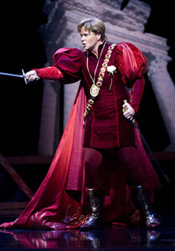Stefan Margita? Well he may not be a household name, even in the dwellings of opera lovers, but he dominated the production of Wagner's Das Rheingold, seen in the last performance of its run on Saturday, June 28th. Francesca Zambello's concept, first seen in Washington D.C., supposedly centers on an "American" perspective. Much more of what that might entail appeared in the program essay than on stage. Alberich carried a pickax, so he might have been a prospector. Since his discovery of the gold actually comes by accident, that profile made little sense. The Rheinmaidens looked much as they usually do, and the first stage set of ramps swamped by mist made an amorphous impression. Zambello resorted to rather trite imagery for the film screen back drop, including a mountain stream and space imagery right out of any number of corny science fiction films for the opera's prelude. The prospective tenants of Valhalla came dressed as Gatsby-era upper crust types, with gentlemen in pale linen (Donner carried a croquet mallet). For once, Wotan actually was dozing as Fricka woke him, but since she did it with a TV sitcom swap across the head, Wotan started diminished and really never showed any of the character's grandeur or strength. Mark Delevan, however, gave evidence that he has the voice for the role, and could well grow into a more impressive interpretation.
But the opera became Loge's once the elegant, obsequious figure of Stefan Margita slank on stage. Although his voice failed to carry well anytime he turned away from the audience, he had absolute command of the stage otherwise. And conductor Donald Runnicles sooner or later let the orchestra flood over all the singers. The best of Zambello's invention went to the giants, superbly sung and acted by Andrea Silvestrelli (Fasolt) and Günther Groissböck (Fafner). In an interesting twist, the Freia of Tamara Wapinsky apparently found, as Madeline Kahn did in Young Frankenstein, the "sweet mystery of life" with Fasolt, as she clung to him amorously after her abduction, returned reluctantly to her family, and then was inconsolable when Fafner went in for a little fratricide.
Zambello may yet fully develop the "American" perspective as the cycle continues in future seasons. On Saturday night, the production took a lower profile while the singers and orchestra carried the night.
The Sunday matinee audience for Lucia Di Lammermoor basked in the radiant star power of Natalie Dessay, and at least for the first act, her Edgardo, Giuseppe Filianoti, shone as bright. However, after singing with brilliant tone and force through the sextet, the tenor started to wane in the second act. By his great climatic scene, the voice had grown husky and strained at the top. Nonetheless, he was rewarded for the passion of his efforts with a healthy ovation at curtain.
But Dessay brought the crowd to their collective feet. She did not overplay the character's neurosis, and her mad scene truly put the emphasis on the music's depiction of the breakdown, rather than histrionics. The high notes carried a hint of scratchiness, otherwise, the performance almost appeared effortless. Not so that of Gabriele Viviani, the Enrico, whose stout baritone carried well but without any distinctive qualities.
The production, co-directed by Graham Vick and Marco Gandini, gave an atmospheric sense of the moors, especially in the final scene. Brooding skies and a single blasted, twisted tree served most of the other scenes, with sliding panels quickly establishing new locations. The most effective moment came with Lucia's appearance for the mad scene, a "slow reveal" that frankly acknowledged the central place this scene has in the opera's staying power. Conductor Jean-Yves Ossonce provided efficient, if characterless, support.
Unfortunately, OperaToday reviewers are not immune to transportation difficulties, and a slow leak (which should not a problem for a typical gasbag critic) from a tire prevented your reviewer from making the curtain for Tuesday's night's Ariodante . The last half of act one was caught from orchestra standing room, and then, exhausted, your reviewer slipped out of the War Memorial after act two. The conducting of Patrick Summers, routine to a fault, had not helped matters.
No blame for this whatsoever goes to the excellent cast. Susan Graham and Ruth Ann Swenson both sang exquisitely, with admirable support from Richard Croft and Eric Owens. As the villain of the piece, Sonia Prina hammed it up enthusiastically enough but looked fairly ridiculous. The sets and costumes came from Dallas Opera (direction by John Copley and design by John Conklin ). Tall marble columns slid into different formations for each scene, but it always seemed to be the same set. The lavish costumes only emphasized the barrenness of the staging. Some years ago a video appeared of an ENO production of the opera, featuring Ann Murray, which had much more wit and eroticism than this lame affair. Sadly, as your reviewer left after act two so did quite a few other audience members. Maybe they had tire problems to attend to as well...
So ends the 2007-08 SFO season. But the 2008-09 season premieres in just a matter of weeks, with stars such as Dmitri Hvorostovsky and Anna Netrebko lined up. Gockley should perhaps look into bringing back Stefan Margita soon as well.
Chris Mullins
